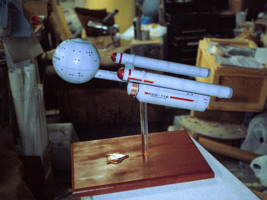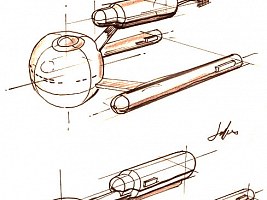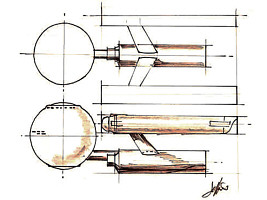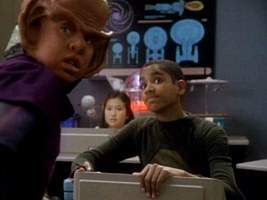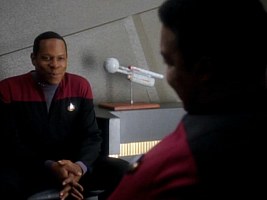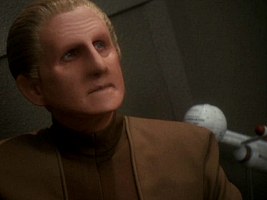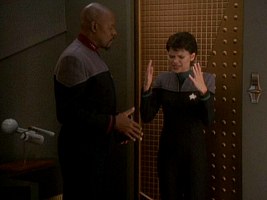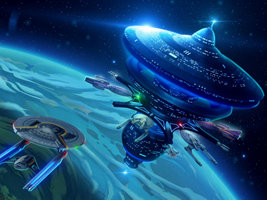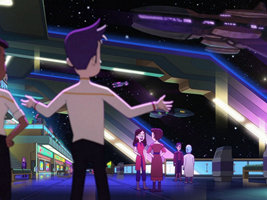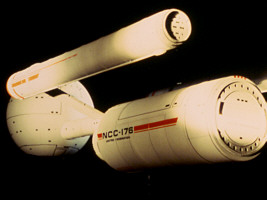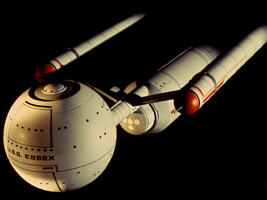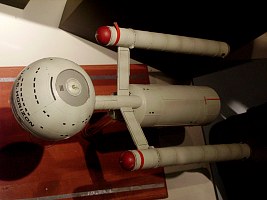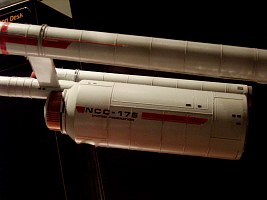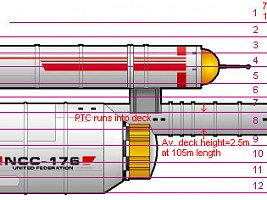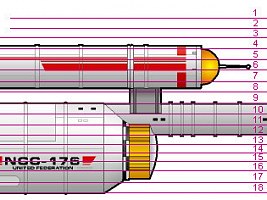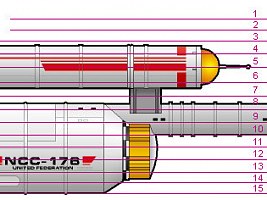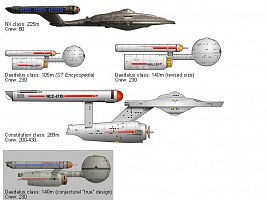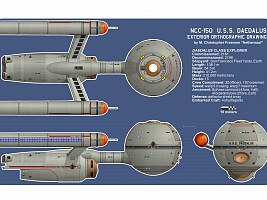Daedalus Class Problems
A miniature of an obviously historical starship with a spherical main hull appears in Keiko's classroom and in Sisko's office on Deep Space 9. The design is depicted alongside definitely canon ships in the Star Trek Encyclopedia I and is identified as Daedalus class (which was verbally known from TNG: "Power Play"). A clear photo of the model in The Art of Star Trek shows the label "USS Horizon NCC-176". Yet, we could never see such a starship in space in a live-action episode.
The most common questions about the Daedalus class are:
- Is the design with the ball-shaped main hull canon at all? After all we could only see the miniature in live-action Trek, never the real thing. Sisko may have built the model as a kid, and like the many fan-made ship designs of the 20th/21st century it may not be based on an actual Starfleet class.
- If Sisko's model depicts the real historical USS Horizon correctly, the ship that gained an odd kind of fame in TOS: "A Piece of the Action", it is still debatable whether this particular vessel belonged to the Daedalus class. The Horizon and hence Sisko's model might be any other class.
- If the design is merely 105m long, with much less internal space than Enterprise NX-01 (complement: 80), a crew of 229 on a Daedalus class is hard to maintain. The figure of 229 being solid canonical evidence, there may be something wrong about the ship's purported size.
- Looking at the photos of Sisko's ship, it does not look at all like it could have been built in the same era as Enterprise NX-01. It is just too primitive with its simplistic "tin can" engineering hull and nacelles. Is it possible that young Sisko has simplified a few things and that it is not an accurate depiction of the real ship class?
- We only know of two Starfleet ship types with a ball as the main hull. Many fans surmise that the Daedalus class and the Olympic class are related in some fashion.
These issues are discussed in the following.
History of Spherical Main Hulls
Some of Matt Jefferies's early sketches of the USS Enterprise are depicted in The Art of Star Trek and Star Trek: The Magazine. The design variants with a spherical main hull were later discarded in favor of the now familiar disk-shaped main section.
No Starfleet ship design with a spherical main hull would appear until the mid-1990s. At that time two models were created as homages to Matt Jefferies and appeared on screen:
Daedalus class
A desktop model built by Greg Jein can be seen in Sisko's ready room in various DS9 episodes. It is closely follows the lines of one of Matt Jefferies's early designs for the original USS Enterprise with a spherical main hull. The only difference is that Jein turned the ship upside down, complying with the orientation of the original Enterprise. Jein's model has a comparably coarse finish. It is intentionally laid out to look outdated. The miniature depicts the USS Horizon, which could have been the vessel mentioned in TOS: "A Piece of the Action" to have disappeared 100 years prior to the episode. In the Star Trek Encyclopedia I there are small photos of the model labeled as "USS Essex" (on the sphere) and as "NCC-176" (on the sides) to illustrate the entries of the three supposed Daedalus-class vessels.
Olympic class
This class is occasionally referred to as "Hope class" (as indicated on the dedication plaque) but is called Olympic class in official publications. The full-scale filming miniature was built by Bill George as an homage to the early sketches of the original Enterprise by Matt Jefferies. Unlike the Daedalus class it is a free-style interpretation of this original idea and retains just the spherical main hull. The rest of the vessel is laid out to look quite "modern". The ship appeared in TNG: "All Good Things" as the 24th century hospital ship USS Pasteur, under the command of Beverly Picard in a parallel timeline.
Many years later, the Olympic class also shows up as the USS Quito in Mariner's flashback in LOW: "Cupid's Errant Arrow", thereby establishing that the design exists in the main timeline just as well and corroborating its canon status (although Lower Decks itself has a lower weight than a live-action series).
For TOS Remastered another ship with a spherical main hull was built as a CGI:
Medusan vessel
This vessel can be seen at the end of TOS-R: "Is There in Truth No Beauty?", replacing an original shot that had no other starship in it at all. The basic design is similar to the Daedalus class style-wise, although the hull proportions of the Medusan vessel are different. Mike Okuda: "The basic idea was Dave Rossi's suggestion. He thought that because the Medusans were non-corporeal and might not have developed technology as we know it, they might use Federation hardware, so their ships could have a distinct Federation style."
The same design as in TOS-R: "Is There in Truth No Beauty?" also appears in a flashback in PRO: "Preludes" as the ship that brings the Medusans to the Delta Quadrant (where Zero is captured by the Kazon). This episode is set over a hundred years later.
Many long-time fans had hoped to see a real Daedalus-class ship in Star Trek Enterprise. The mid-22nd century would have been the era when the USS Essex or USS Horizon were in service or were just about to be commissioned. Actually, as Doug Drexler tells us, if it had been for the Star Trek Art Department, the NX class would have looked like the Daedalus class! But the producers decided in favor of a "sexier" Akira-class derivate.
Canon Status
Authenticity of the design
As already mentioned, we can never see the "real" Daedalus class in space in live-action Trek, but only the model on DS9. It can be seen in Sisko's office on various occasions. So if we are very critical we could suspect that young Sisko (assuming that he is the builder and rather not Jake who was never much interested in starships) did not base this model on a real Starfleet ship class. Not unlike the Star Trek fans of the 20th/21st century he may have designed a starship as it could have existed about 200 years before his time. He labeled the ship as "USS Horizon", but it does not have to be the very same ship that was mentioned in TOS: "A Piece of the Action".
On the other hand, we almost customarily surmise that desktop models are authentic, perhaps with the sole exception of the odd Constitution class with missing window insets. And over the course of his seven years on Deep Space 9 Sisko has three more models in his office that have to be considered realistic: the Saratoga and Proto-Nebula #3 as well as the ISS (albeit in a configuration never actually built). Moreover, there is an even better rationale why the model should depict a real ship: On one occasion, in DS9: "The Nagus", we can see it in Keiko's classroom, along with the model of the Saratoga and a chart of historical Earth and Starfleet vessels. Keiko obviously borrowed the models from him as perfect additions to a lesson on spaceflight history.
Overall, there is sufficient reason to believe that the starship class with the spherical main hull actually existed, probably in the 22nd century. But is this design the canonical Daedalus class?
 An actual Daedalus class appears as late as in Lower Decks. Two of these ships can be seen docked at the starbase in LOW: "An Embarrassment of Dooplers". They are clearly supposed to be Daedalus-class ships. We might explain why one museum ship is docked to the (old) station, perhaps permanently, but the existence of two Daedaluses seems like a stretch. We can also see that the ships have illuminated nacelles. So the interpretation is possible that these are two newer ships that resemble the Daedalus. The length of just around 100m, on the other hand, looks just right, complying with the Star Trek Encyclopedia.
An actual Daedalus class appears as late as in Lower Decks. Two of these ships can be seen docked at the starbase in LOW: "An Embarrassment of Dooplers". They are clearly supposed to be Daedalus-class ships. We might explain why one museum ship is docked to the (old) station, perhaps permanently, but the existence of two Daedaluses seems like a stretch. We can also see that the ships have illuminated nacelles. So the interpretation is possible that these are two newer ships that resemble the Daedalus. The length of just around 100m, on the other hand, looks just right, complying with the Star Trek Encyclopedia.
Correspondence of design and class name
We know from TNG: "Power Play" that there used to be a Daedalus class of starships, to which the USS Essex NCC-173 belonged, with a crew complement of 229. The class was decommissioned by 2196. But this information is only verbal and is not linked to a particular design in the TNG episode.
The Star Trek Encyclopedia I is the first publication to mention the Daedalus class. The book lists three canon ships from TOS and TNG as belonging to this class:
| Ship name | Episode | Time frame | Visible | Confirmed class | Illustration |
| USS Archon NCC-189 | TOS: "Return of the Archons" | 2167 | No | No | Rear view, illegible name |
| USS Essex NCC-173 | TNG: "Power Play" | prior to 2168 | No | Yes | Front view, "USS Essex" legible |
| USS Horizon NCC-176 | TOS: "A Piece of the Action" | 2168 | No | No | Rear view, illegible name |
| DS9, in Sisko's office | Unknown | Yes | No |
It becomes clear that the Archon and the Horizon from TOS were retroactively classified as Daedalus class in the Star Trek Encyclopedia I. None of the three ships was ever seen as a "real" vessel in space. The registry of the Archon was never shown or mentioned, whereas the NCC-173 of the Essex was stated in the episode and the NCC-176 of the Horizon is visible on Sisko's model.
The Star Trek Encyclopedia II adds another individual Daedalus-class vessel that was still listed as "unknown class" in the previous edition:
| Ship name | Episode | Time frame | Visible | Confirmed class | Illustration |
| USS Carolina NCC-160 | TOS: "Friday's Child" | 2268 | No | No | None |
The Carolina's appearance in the year 2268 is in conflict with the canon statement that the class has already been retired by 2196 from "Power Play". The ship was made up by the Klingons as a ruse anyway, but we should assume that their forgery would be realistic enough to deceive a Starfleet crew. It was not a good idea to list the ship as another Daedalus class in the second edition of the book. I think we can ignore this one ship as a possible member of the Daedalus class.
Had Sisko labeled his model ship "USS Essex NCC-173", we would have definite proof that this is the actual look of the historical Daedalus class and not of another ship class of the 22nd century. But since his Horizon bears the registry NCC-176, it is quite plausible that this ship belongs to the Daedalus class too. And it is only a small leap of faith to accept the little bit of retconning that was done in the Star Trek Encyclopedia pertaining to the Archon, although it is not strictly canon.
Design-Related Questions
Model design evolution
Greg Jein's model of the Daedalus is in the same tradition as his Valiant and the 22nd century Romulan ship that he built for the Star Trek Chronology. The two latter vessels have to be rated as non-canon. We have to keep in mind that all these models were not intended to ever appear on screen but only as depictions of some 5cm in a book. Yet, while following the lines of Jefferies's sketch Jein made the ship look like a reasonable step between contemporary spacecrafts (note the "ribbing" on the nacelles just as on the booster rockets of the space shuttle) and the Constitution class. The details on the Daedalus model may not hold up to a close examination though. One frequently posed question is where the impulse engines could be located on the Daedalus, my best guess being that it is the ring of small holes at the aft end.
As already mentioned, Greg Jein's model of the Daedalus class bore the name "USS Essex" on the sphere, and the registry "NCC-176" (of the Horizon) on the engineering hull when it was shot for the Star Trek Encyclopedia I. When the model was prepared to be displayed as the Horizon in Sisko's office, the name on the ship may have been accordingly modified. This seems to explain why there are two differently labeled versions of the model on the available photos.
In addition, however, the Horizon in Sisko's office looks a bit crude with its raised hull lines compared to Jein's original Essex. The reason is that there used to be two distinct models.
Mike Okuda explains: "There were at least two models of the Horizon/Essex. The first was the one that Greg built for the Chronology. I later asked Greg to make a casting of that model, so we could use it as set dressing in Sisko's office. I believe he made another casting for display at Star Trek: The Experience. I may still have the original model somewhere, although I seem to recall it was damaged in an earthquake some years ago... The 'painted over stripes' were present on the cast resin copies. The original stripes were fairly thick graphic tape, so they showed up as ridges on the cast copies. Doug [Drexler] and I did the taping after Greg delivered the finished model. We also applied tape over the ridges on the copy in Sisko's office, at least partially, but I don't think we ever got a chance to tape the copy made for The Experience."
Size of the ship
The length of the Daedalus class is given as 105m in the Star Trek Encyclopedia I in a size comparison with other Starfleet ships, but there is no screen evidence or other reliable scaling reference. The scale may have been quickly made up in an attempt to make the Daedalus appear much less powerful than the later ships in the Star Trek Encyclopedia I. The crew complement of 229 (which most likely includes scientists) given in TNG: "Power Play" casts doubt on the size figure.
At 105m the Daedalus class has about twice the internal volume of a present-day Seawolf-class submarine. The crew complement of the Seawolf class is 140, so having twice as many on the starship (with berths being shared among the crewman) would be physically possible, provided that the percentage of inhabitable volume is about the same. However, for starships we generally expect considerably more space for the crew (or for machinery, control rooms, labs, fuel and supplies). 100 years later the 289m long Constitution class would support a crew of as many as 430, but with roughly five times the internal volume of the 105m Daedalus class. And only a few years prior to the Daedalus class the NX class is operated by a crew of as few as 80, with a volume not much smaller than the Constitution. In other words, the Daedalus would have to be considerably longer than 105m to be plausible with a crew of 229.
Not only the crew count but also the design itself bears evidence that the ship has to be larger. At 105m the Daedalus class could have at most 12 decks, and these would have an average height of merely 2.5m. The depiction of the Daedalus class in various publications such as the Star Trek Fact Files reproduces the deck structure (visible as window rows) with sufficient accuracy for our purposes. There are, however, some extraneous windows on the diagrams that do not exist on the real model. I have removed these windows on my Daedalus side view.
When I try to subdivide the useful height of the ship into 12 roughly equally spaced decks, there are several problems. First of all, the bridge would have to be submerged, and still its width would be at most 7m, more likely even one meter less considering that the walls should be reinforced and also full of circuitry. The neck would measure just 5m across. This is problematic especially since the warp pylons would run straight through the only inhabitable deck in the thin neck. Furthermore, several windows would have to be close to the bottom of the respective deck, and with only 12 decks altogether of an average height of 2.5m there would just not be enough flexibility in the internal structure to have exceptionally tall decks, or two decks combined to one. Overall, the external arrangement does not support a very short ship of 105m.
The visible window arrangement works out much better if there are 18 decks altogether. If these decks have a reasonable average height of 3m, we end up at a length of the ship of 180m. At this length the Daedalus class would almost rival the Constitution class volume-wise, despite being much shorter. It would be no problem at all to accommodate the crew of 229 with all supplies, fuel and shuttles. Still, it doesn't feel right that a ship almost as large as a Constitution class should have much smaller nacelles.
Maybe, while the overall proportions are correct, Sisko didn't get the window spacings quite right when he built the model? At least, that is what we could pretend in order to allow the ship to be composed of 15 decks of 2.8m each, giving us an overall length of 140m. This is just a compromise, but it keeps the ship reasonably small compared to the Constitution class, while it alleviates all the problems of the 105m Daedalus. The size comparison with the NX class and the Constitution class demonstrates that the Daedalus class works well at a length of 140m.
Model accuracy
The remaining question about the design is how it could fit into the post-Enterprise design lineage now that we have a contemporary NX class, whose structure is a lot more complex than the primitive looking "tin can" engineering hull and nacelles of the Daedalus. Looking at the finish of the model and at the window placements, we are probably allowed to presuppose that Sisko's model is meant to depict the historical Daedalus class but is not quite accurate in all details. But are we allowed to go one step further and pretend that Sisko (or whoever built the model in-universe) took some more liberties and simplified the overall structure of his model?
It is certainly a matter of preference how much we would like the Daedalus-class to be retconned, but the real ship should certainly be more detailed than what we see in Sisko's office. A conjectural Daedalus redesign by M. Christopher Freeman is intriguing because its overall proportions are the same as those of Sisko's model, while it includes all the typical details of the NX class. It is well imaginable that young Sisko saw depictions of this "true" Daedalus class and tried to build his model as accurately as possible. But using traditional tools and perhaps even material such as a real plastic bottle for the secondary hull he didn't get the shapes quite right, and he didn't care so much about the many details.
Since we don't have any evidence that the true Daedalus really looks any different, Sisko's model will continue to represent this ship class at EAS though, but only as some sort of placeholder.
Design lineage
The Olympic class customarily shows up as a successor of the Daedalus in fan-made family trees. The obvious reason is that these two are the only known Starfleet ships with a ball-shaped main hull. But are the two ship designs really related?
I think the superficial similarity of the classes has to be a coincidence. For all we know the Daedalus class must have been a type of explorer of the 22nd century, much like the Constitution in the 23rd and the Galaxy in the 24th century. All three Daedalus-class vessels that we know of were lost in remote regions of space and discovered one or even two centuries later. The Horizon and Archon were even explicitly on missions that involved making first contact with alien civilizations. In contrast, the Pasteur is a medical support vessel or hospital ship. It is fast, but is apparently not equipped for scientific missions and it is only lightly armed.
There are a couple of design generations between the Daedalus and the Pasteur, and while there may be a certain tradition to build some ships with a spherical main hull, rather than saucers, there is no reason to believe that the Pasteur evolved from the Daedalus in any fashion. Likewise, as the technology must have changed a lot in the course of 200 years, there is no reason to assume that the Akira class may have descended from the NX class, although the similarities of these two vessels are even much more obvious. Perhaps the reason to choose a spherical main hull for the Olympic-class medical vessel was the optimized accessibility of all rooms through a central turbolift cluster.
Conclusion
Although definite proof in live action is missing, there is sufficient reason to believe that Sisko's model depicts the historical USS Horizon, and that the Horizon, like the Essex and the Archon, belonged to the canon Daedalus class. The small retconning done by the Okudas for the Star Trek Encyclopedia I absolutely makes sense.
Regarding the size and the exact design of the vessel, we are probably allowed to assume that the "real" Daedalus class is more detailed than the model in Sisko's office and that the window arrangement is slightly different. The vessel is definitely longer than the 105m given in the Encyclopedia, while it should be shorter than 180m in order not to rival the Constitution class. A Daedalus class of 140m is just a compromise, but in a size comparison with the NX class and the Constitution class it works out quite nicely.
Finally, there is no good reason to assume that the explorer of the Daedalus class and the 200 years younger hospital ship of the Olympic class should be in any way related just because they both have a ball-shaped main hull.
Credits
This article wouldn't have been possible without the support of Andrew Reynolds, who provided measurements and comparisons and who suggested to care about this topic in the first place. Thanks also to Doug Drexler and Maurice Molyneaux for some of the photos, to Jörg for most screen caps, to Masao Okazaki for the Daedalus-class side view, to Paul Cargile for the comparison with the Seawolf and to Richard Shepherd, Chris Boucher and C. Todd Forthman for additional ideas. Special thanks to M. Christopher Freeman for his great redesign of the Daedalus. Find more of his work in the historical section of the JoAT.

Back to Starship Articles index






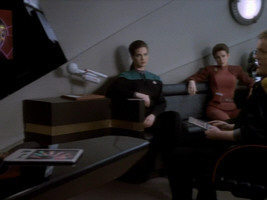
 Daedalus model in DS9: "If Wishes Were Horses"
Daedalus model in DS9: "If Wishes Were Horses"